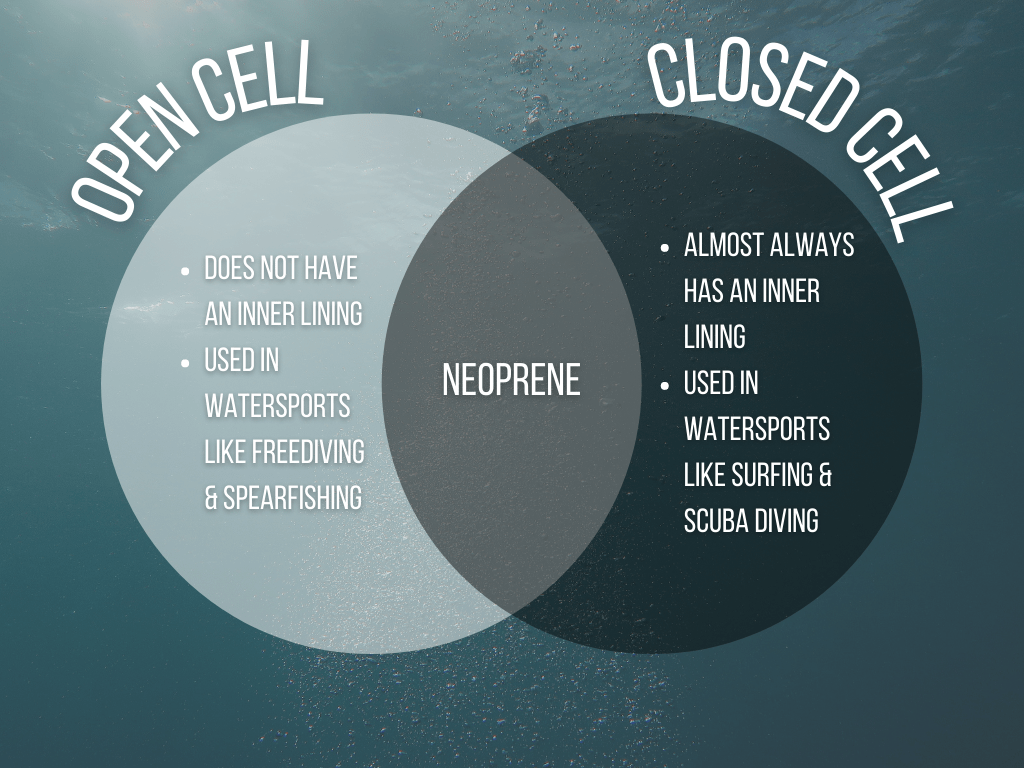Open Cell vs Closed Cell Wetsuits
Wes Severson April 13th, 2021 Posted In: Articles
Open Cell vs Closed Cell Wetsuits
Everyone wants options these days and the wetsuit world is no different. There are several different types on the market today that suit all the different sports that require them. One of the most common questions that we’ve run into is this: Open cell wetsuit vs. closed cell, which is right for me?
That fact is, knowing the difference between open cell vs. closed cell wetsuits is very important in the world of water sports. In the battle of closed cell vs. open cell wetsuits, there isn’t one that is necessarily better than the other because they are essentially made for different things. After reading this you’ll know the differences, the concerns, and the uses when it comes to open vs. closed cell wetsuits.
The Big Difference
We all know that wetsuits are made from neoprene which is a rubber substance filled with tiny air bubbles that make it totally waterproof while giving it very efficient insulating properties. The difference between open cell wetsuits vs. closed cell is totally based on the linings that are attached to the neoprene.
Open Cell Wetsuits
An open cell wetsuit does not have an inner lining which means the rubbery neoprene goes right up against the skin. The porous nature of neoprene creates millions of tiny suction cups that stick to the skin making it impossible for water to get in. Open cell wetsuits can also be referred to as ‘semi-dry’ suits since they don’t let water touch the skin. This may sound like a huge advantage and it is, but there are also big disadvantages to open cell wetsuits that we will talk about soon.
Closed Cell Wetsuits
If the competition behind open cell versus closed cell wetsuits was based on popularity and commonality, closed cell wetsuits would win every time. The reason is, they are used in many more activities compared to an open-cell wetsuit. Athletes in most common water sports like surfing, swimming, and scuba diving use closed cell wetsuits.
Closed cell wetsuits have a piece of nylon, polyester, or some other fabric that serves as an inner lining to the wetsuit. The lining eliminates the skin-to-neoprene contact which means there are no suction cups and water does come into the wetsuit and in contract with the skin. But since the wetsuit fits so tightly to the skin only a thin layer of water is able to get inside. When you are moving around this water gets heated to your body temperature which in turn, keeps you warm.
Surfing vs Scuba Diving Wetsuits
Closed cell wetsuits are the most common types for both of these activities, however, you may notice that wetsuits made for scuba diving have a lining both on the inside and the outside of the suit. The reason for the outer lining is to give you another layer of warmth and to protect the suit from nicks and tears that could ruin the suit. Scuba divers deal with a lot more equipment and obstacles in the water compared to surfers and also go deeper into the water so the added outside lining helps a lot for both warmth and protection.
Most surfing wetsuits have bare neoprene exposed on the outside of the suit because surfers don’t deal with many obstacles that can tear their suit. Most of the time surfers only come into contact with their board and the sand. Surfers also stay at the surface of the ocean where the warmest waters exist and they are moving around a lot which means they don’t need that extra layer of warmth on the outside.
Who Wears Open Cell Suits?
As we talk about open vs closed cell wetsuits, you might be thinking, who actually needs an open cell wetsuit? Freedivers, spearfishing enthusiasts, and other activities that require you to hit deep, cold water dozens of feet below the surface are the predominant users of open cell wetsuits. Freediving and spearfishing also don’t require as much movement as other water sports which means the athletes won’t be helping to keep themselves warm through body heat.
Open Cell Disadvantages
When comparing open cell wetsuits vs. closed cell wetsuits it is important to note that open cell suits have far more disadvantages compared to closed cell. The biggest factor is strength. Since it is filled with air bubbles, neoprene is weak and tears very easily. Without an inner lining to give it added strength, the neoprene alone becomes very vulnerable to damage that can ruin it.
Also, because of the suction-like properties on the inside of the wetsuit, an open cell wetsuit is much harder to put on compared to a closed cell suit which just slides on. Open cell suits require a lubricant to be put on before you slide it on your body. Without a specially made substance from a wetsuit company or something like soap, you will not be able to put the wetsuit on without tearing it.
Another thing to consider when comparing closed cell vs. open cell wetsuits is cost. Open cell wetsuits cost more than closed cell suits because they are more intricate to make. But there are a couple of advantages. The obvious one is an open cell wetsuit is warmer. But they are also more flexible. Since an open cell suit keeps you totally dry, the neoprene doesn’t need to be as thick to keep you warm. That means it is easier to move around in it compared to a thicker, closed cell wetsuit.
So, as you can see, the differences between open cell vs closed cell wetsuits are pretty clear. After reading this you should be ready to shop for the one that suits your needs best.


